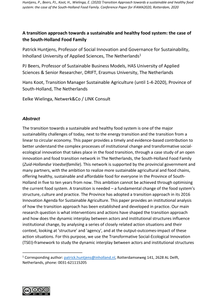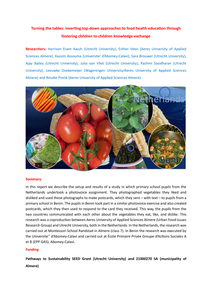Change is endemic in modern society, and the educational systems that operate in it. In Higher Education societal trends such as globalization and economic rationalism are impacting on teachers. Changes in the student population, new educational methods derived from shifting perspectives on the role of knowledge and re-structuring of the organizations within which teachers work have also led to transformation of the professional context. At European level policy initiatives such as the Bologna Declaration (1999) have necessitated an overhaul of educational provision. This research project attempts to focus on these wideranging changes through the lens of teacher autonomy in order to establish what is changing in the working lives of teachers in a Dutch university, how they are responding to these changes and how they can be helped to respond to change effectively and discriminatingly. This is an insider research project, using case study and semi-structured interviewing to yield data that is subjected to thematic linguistic analysis. It was piloted in 2006, and interviewing was resumed in February 2007. Findings indicate the contested nature of teacher autonomy, and suggest that professional autonomy can impede as well as facilitate teachers in processes of engaging with change. The team - operating as a community of practice - is identified as the location where change agency can operate most effectively. Distributed leadership - specifically perceived in the activities of team leaders and teacher change agents - is seen as crucial to processes of embedding change in educational practice.
DOCUMENT

Na het uitbreken van de Covid-19 pandemie heeft digitale participatie een grote vlucht genomen. Door de pandemie was het niet of nauwelijks mogelijk om fysiek bij elkaar te komen. Informatie of inspraakbijeenkomsten konden niet langer op een locatie in de buurt worden georganiseerd. Noodgedwongen vond er een verschuiving plaats van offline naar online burgerparticipatie. Hierdoor is er de afgelopen jaren veel ervaring opgedaan met digitale participatie. De verwachting is dat nu er weer van alles mogelijk is, er vaker gebruik gemaakt zal blijven worden van online participatievormen en - instrumenten. De koudwatervrees voor online participatie lijkt definitief overwonnen. In de toekomst zullen participatiestrategieën worden ontwikkeld waarin online- en offline-instrumenten vaker afwisselend en in onderlinge samenhang worden ingezet. Deze geïntegreerde inzet roept vragen op over de doorontwikkeling van digitale participatie. Hoe kunnen professionals op basis van de ervaringen met digitale participatie de afgelopen jaren de mogelijkheden hiervan in de toekomst beter benutten? En hoe kan er op basis van de ervaring die is opgedaan richting worden gegeven aan de doorontwikkeling van digitale tools?
DOCUMENT

Purpose: This study, a conceptual paper, analyses the growth of curation in tourism and hospitality and the curator role in selecting and framing products and experiences. It considers the growth of expert, algorithmic, social and co-creative curation modes and their effects. Design/methodology/approach: Narrative and integrative reviews of literature on curation and tourism and hospitality are used to develop a typology of curation and identify different curation modes. Findings: Curational techniques are increasingly used to organise experience supply and distribution in mainstream fields, including media, retailing and fashion. In tourism and hospitality, curated tourism, curated hospitality brands and food offerings and place curation by destination marketing organisations are growing. Curation is undertaken by experts, algorithms and social groups and involves many of destination-related actors, producing a trend towards “hybrid curation” of places. Research limitations/implications: Research is needed on different forms of curation, their differential effects and the power roles of different curational modes. Practical implications: Curation is a widespread intermediary function in tourism and hospitality, supporting better consumer choice. New curators influence experience supply and the distribution of consumer attention, shaping markets and co-creative activities. Increased curatorial activity should stimulate aesthetic and stylistic innovation and provide the basis for storytelling and narrative in tourism and hospitality. Originality/value: This is the first study of curational strategies in tourism and hospitality, providing a definition and typology of curation, and linking micro and macro levels of analysis. It suggests the growth of choice-based logic alongside service-dominant logic in tourism and hospitality.
MULTIFILE
The transition towards a sustainable and healthy food system is one of the major sustainability challenges of today, next to the energy transition and the transition from a linear to circular economy. This paper provides a timely and evidence-based contribution to better understand the complex processes of institutional change and transformative social-ecological innovation that takes place in the food transition, through a case study of an open innovation and food transition network in The Netherlands, the South-Holland Food Family (Zuid-Hollandse Voedselfamilie). This network is supported by the provincial government and many partners, with the ambition to realize more sustainable agricultural and food chains, offering healthy, sustainable and affordable food for everyone in the Province of South-Holland in five to ten years from now. This ambition cannot be achieved through optimising the current food system. A transition is needed – a fundamental change of the food system’s structure, culture and practice. The Province has adopted a transition approach in its 2016 Innovation Agenda for Sustainable Agriculture. This paper provides an institutional analysis of how the transition approach has been established and developed in practice. Our main research question is what interventions and actions have shaped the transition approach and how does the dynamic interplay between actors and institutional structures influence institutional change, by analysing a series of closely related action situations and their context, looking at 'structure' and 'agency', and at the output-outcomes-impact of these action situations. For this purpose, we use the Transformative Social-Ecological Innovation (TSEI)-framework to study the dynamic interplay between actors and institutional structures influencing institutional change. The example of TSEI-framework application in this paper shows when and how local agents change the institutional context itself, which provides relevant insights on institutional work and the mutually constitutive nature of structure and agency. Above institutional analysis also shows the pivotal role of a number of actors, such as network facilitators and provincial minister, and their capability and skills to combine formal and informal institutional environments and logics and mobilize resources, thereby legitimizing and supporting the change effort. The results are indicative of the importance of institutional structures as both facilitating (i.e., the province’s policies) and limiting (e.g. land ownership) transition dynamics.
DOCUMENT

Accurate assessment of rolling resistance is important for wheelchair propulsion analyses. However, the commonly used drag and deceleration tests are reported to underestimate rolling resistance up to 6% due to the (neglected) influence of trunk motion. The first aim of this study was to investigate the accuracy of using trunk and wheelchair kinematics to predict the intra-cyclical load distribution, more particularly front wheel loading, during hand-rim wheelchair propulsion. Secondly, the study compared the accuracy of rolling resistance determined from the predicted load distribution with the accuracy of drag test-based rolling resistance. Twenty-five able-bodied participants performed hand-rim wheelchair propulsion on a large motor-driven treadmill. During the treadmill sessions, front wheel load was assessed with load pins to determine the load distribution between the front and rear wheels. Accordingly, a machine learning model was trained to predict front wheel load from kinematic data. Based on two inertial sensors (attached to the trunk and wheelchair) and the machine learning model, front wheel load was predicted with a mean absolute error (MAE) of 3.8% (or 1.8 kg). Rolling resistance determined from the predicted load distribution (MAE: 0.9%, mean error (ME): 0.1%) was more accurate than drag test-based rolling resistance (MAE: 2.5%, ME: −1.3%).
DOCUMENT

Full text met een HU Account Objective: To quantify diversity in components of self-management interventions and explore which components are associated with improvement in health-related quality of life (HRQoL) in patients with chronic heart failure (CHF), chronic obstructive pulmonary disease (COPD), or type 2 diabetes mellitus (T2DM). Methods: Systematic literature search was conducted from January 1985 through June 2013. Included studies were randomised trials in patients with CHF, COPD, or T2DM, comparing self-management interventions with usual care, and reporting data on disease-specific HRQoL. Data were analysed with weighted random effects linear regression models. Results: 47 trials were included, representing 10,596 patients. Self-management interventions showed great diversity in mode, content, intensity, and duration. Although self-management interventions overall improved HRQoL at 6 and 12 months, meta-regression showed counterintuitive negative effects of standardised training of interventionists (SMD = 0.16, 95% CI: 0.31 to 0.01) and peer interaction (SMD = 0.23, 95% CI 0.39 to 0.06) on HRQoL at 6 months. Conclusion: Self-management interventions improve HRQoL at 6 and 12 months, but interventions evaluated are highly heterogeneous. No components were identified that favourably affected HRQoL. Standardised training and peer interaction negatively influenced HRQoL, but the underlying mechanism remains unclear. Practice implications: Future research should address process evaluations and study response to selfmanagement on the level of individual patients
MULTIFILE

Background: Marital status is associated with prognosis in patients with cardiovascular disease (CVD). However, the influence of partners on successful modification of lifestyle-related risk factors (LRFs) in secondary CVD prevention is unclear. Therefore, we studied the association between the presence of a partner, partner participation in lifestyle interventions and LRF modification in patients with coronary artery disease (CAD). Methods: In a secondary analysis of the RESPONSE-2 trial (n = 711), which compared nurse-coordinated referral to community-based lifestyle programs (smoking cessation, weight reduction and/or physical activity) to usual care in patients with CAD, we investigated the association between the presence of a partner and the level of partner participation on improvement in >1 LRF (urinary cotinine <200 ng/l, ≥5% weight reduction, ≥10% increased 6-min walking distance) without deterioration in other LRFs at 12 months follow-up. Results: The proportion of patients with a partner was 80% (571/711); 19% women (108/571). In the intervention group, 48% (141/293) had a participating partner in ≥1 lifestyle program. Overall, the presence of a partner was associated with patients' successful LRF modification (adjusted risk ratio (aRR) 1.93, 95% confidence interval (CI) 1.40-2.51). A participating partner was associated with successful weight reduction (aRR 1.73, 95% CI 1.15-2.35). Conclusion: The presence of a partner is associated with LRF improvement in patients with CAD. Moreover, patients with partners participating in lifestyle programs are more successful in reducing weight. Involving partners of CAD patients in weight reduction interventions should be considered in routine practice.
DOCUMENT

This paper starts with the explanation of the research rationale of the professorship. Subsequently, an exploration of the research agenda is provided, focusing on the two core research themes of the professorship: transformational content strategy and transformational content design. Within this section, knowledge gaps will be identified and examples will be presented of research projects related to each theme. Finally, light will be shed on the research approach, offering a brief overview of the theoretical approach, research methodology, and expected impact.
DOCUMENT

In this report we describe the setup and results of a study in which primary school pupils from the Netherlands undertook a photovoice assignment. They photographed vegetables they liked and disliked and used these photographs to make postcards, which they sent – with text – to pupils from a primary school in Benin. The pupils in Benin took part in a similar photovoice exercise and also created postcards, which they then used to respond to the card they received. This way, the pupils from the two countries communicated with each other about the vegetables they eat, like, and dislike.
DOCUMENT
